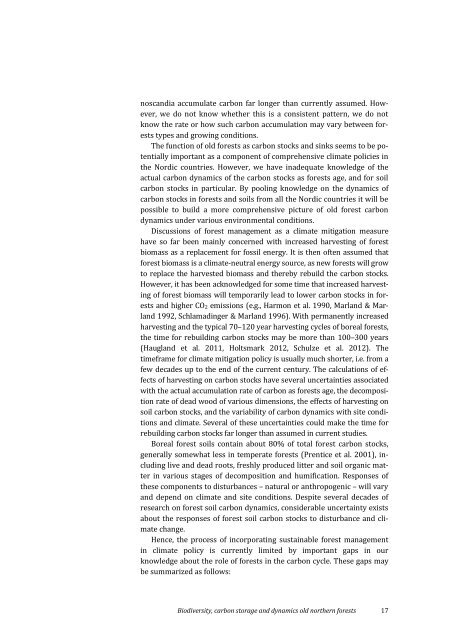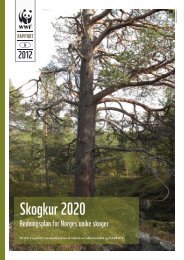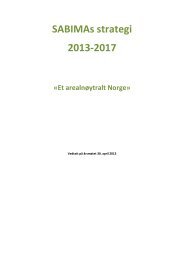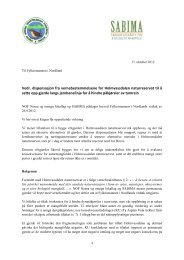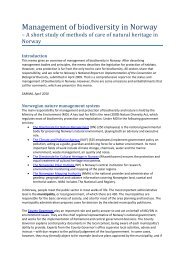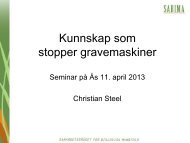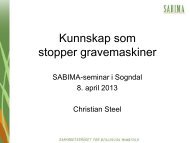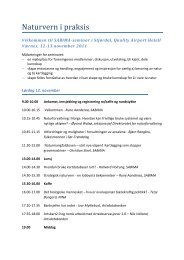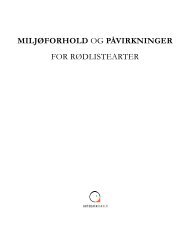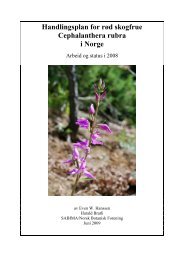Biodiversity, carbon storage and dynamics of old northern ... - BPAN.fi
Biodiversity, carbon storage and dynamics of old northern ... - BPAN.fi
Biodiversity, carbon storage and dynamics of old northern ... - BPAN.fi
Create successful ePaper yourself
Turn your PDF publications into a flip-book with our unique Google optimized e-Paper software.
nosc<strong>and</strong>ia accumulate <strong>carbon</strong> far longer than currently assumed. However,<br />
we do not know whether this is a consistent pattern, we do not<br />
know the rate or how such <strong>carbon</strong> accumulation may vary between forests<br />
types <strong>and</strong> growing conditions.<br />
The function <strong>of</strong> <strong>old</strong> forests as <strong>carbon</strong> stocks <strong>and</strong> sinks seems to be potentially<br />
important as a component <strong>of</strong> comprehensive climate policies in<br />
the Nordic countries. However, we have inadequate knowledge <strong>of</strong> the<br />
actual <strong>carbon</strong> <strong>dynamics</strong> <strong>of</strong> the <strong>carbon</strong> stocks as forests age, <strong>and</strong> for soil<br />
<strong>carbon</strong> stocks in particular. By pooling knowledge on the <strong>dynamics</strong> <strong>of</strong><br />
<strong>carbon</strong> stocks in forests <strong>and</strong> soils from all the Nordic countries it will be<br />
possible to build a more comprehensive picture <strong>of</strong> <strong>old</strong> forest <strong>carbon</strong><br />
<strong>dynamics</strong> under various environmental conditions.<br />
Discussions <strong>of</strong> forest management as a climate mitigation measure<br />
have so far been mainly concerned with increased harvesting <strong>of</strong> forest<br />
biomass as a replacement for fossil energy. It is then <strong>of</strong>ten assumed that<br />
forest biomass is a climate-neutral energy source, as new forests will grow<br />
to replace the harvested biomass <strong>and</strong> thereby rebuild the <strong>carbon</strong> stocks.<br />
However, it has been acknowledged for some time that increased harvesting<br />
<strong>of</strong> forest biomass will temporarily lead to lower <strong>carbon</strong> stocks in forests<br />
<strong>and</strong> higher CO 2 emissions (e.g., Harmon et al. 1990, Marl<strong>and</strong> & Marl<strong>and</strong><br />
1992, Schlamadinger & Marl<strong>and</strong> 1996). With permanently increased<br />
harvesting <strong>and</strong> the typical 70–120 year harvesting cycles <strong>of</strong> boreal forests,<br />
the time for rebuilding <strong>carbon</strong> stocks may be more than 100–300 years<br />
(Haugl<strong>and</strong> et al. 2011, Holtsmark 2012, Schulze et al. 2012). The<br />
timeframe for climate mitigation policy is usually much shorter, i.e. from a<br />
few decades up to the end <strong>of</strong> the current century. The calculations <strong>of</strong> effects<br />
<strong>of</strong> harvesting on <strong>carbon</strong> stocks have several uncertainties associated<br />
with the actual accumulation rate <strong>of</strong> <strong>carbon</strong> as forests age, the decomposition<br />
rate <strong>of</strong> dead wood <strong>of</strong> various dimensions, the effects <strong>of</strong> harvesting on<br />
soil <strong>carbon</strong> stocks, <strong>and</strong> the variability <strong>of</strong> <strong>carbon</strong> <strong>dynamics</strong> with site conditions<br />
<strong>and</strong> climate. Several <strong>of</strong> these uncertainties could make the time for<br />
rebuilding <strong>carbon</strong> stocks far longer than assumed in current studies.<br />
Boreal forest soils contain about 80% <strong>of</strong> total forest <strong>carbon</strong> stocks,<br />
generally somewhat less in temperate forests (Prentice et al. 2001), including<br />
live <strong>and</strong> dead roots, freshly produced litter <strong>and</strong> soil organic matter<br />
in various stages <strong>of</strong> decomposition <strong>and</strong> humi<strong>fi</strong>cation. Responses <strong>of</strong><br />
these components to disturbances – natural or anthropogenic – will vary<br />
<strong>and</strong> depend on climate <strong>and</strong> site conditions. Despite several decades <strong>of</strong><br />
research on forest soil <strong>carbon</strong> <strong>dynamics</strong>, considerable uncertainty exists<br />
about the responses <strong>of</strong> forest soil <strong>carbon</strong> stocks to disturbance <strong>and</strong> climate<br />
change.<br />
Hence, the process <strong>of</strong> incorporating sustainable forest management<br />
in climate policy is currently limited by important gaps in our<br />
knowledge about the role <strong>of</strong> forests in the <strong>carbon</strong> cycle. These gaps may<br />
be summarized as follows:<br />
<strong>Biodiversity</strong>, <strong>carbon</strong> <strong>storage</strong> <strong>and</strong> <strong>dynamics</strong> <strong>old</strong> <strong>northern</strong> forests 17


